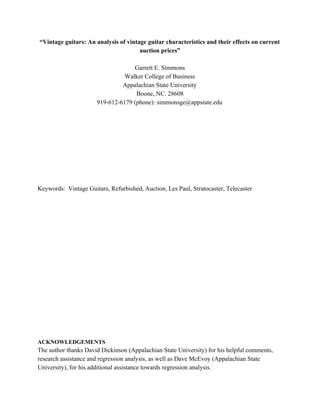
ResearchPaper (1)
- 13. Table 1 Characteristics affecting prices of vintage guitars (dep variable = Price of vintage guitar at transaction), (standard errors in parenthesis) Variable Model 1 Model 2 Model 3 Intercept 35927.76 (3534.31)*** 20427.92 (4841.91)*** 21380.79 (4881.47)*** Age (2016 Prod. Year) 904.71 (66.98)*** 489.43 (99.37)*** 484.41 (99.72)*** Pre1965 (0,1) 5279.95 (1208.92)*** 5456.94 (1213.58)*** Condition (08 scale) 746.37 (410.78)* 1146.11 (498.44)^^^ Refurb (0,1) 7759.15 (890.91)*** 2956.75 (3516.81) Condition*Refurb 1240.43 (878.84)^ Stratocaster (0,1) 253.68 (866.04) 242.22 (864.77) Les Paul (0,1) 1682.77 (1172.45) 1532.70 (1175.49) Finish (0,1) 3453.42 (1179.52)*** 3419.90 (1177.96)*** Reissue (0,1) 5106.28 (984.34)*** 5049.23 (983.68)*** Rsquared 0.354 0.545 0.548 *,**,*** indicate significance at the .10, .05, and .01 levels, respectively, for 2tailed test. ^,^^,^^^ indicate significance at the .10, .05, and .01 levels, respectively, for 1tailed test. Figure 1 Figure 2 12